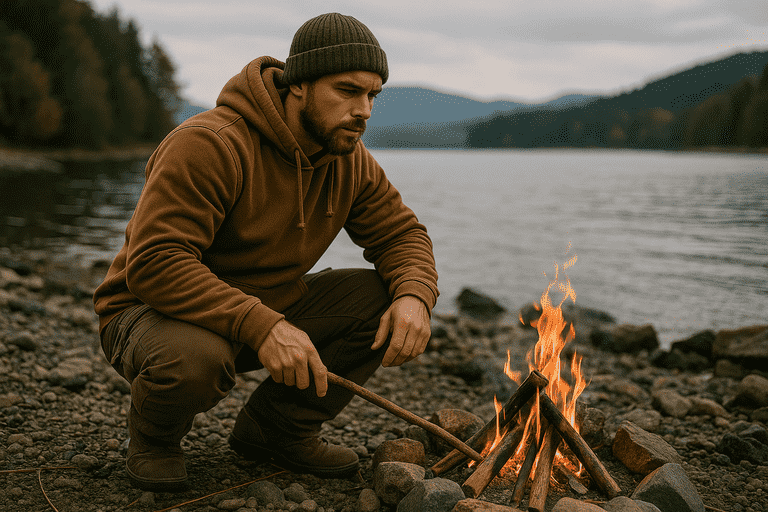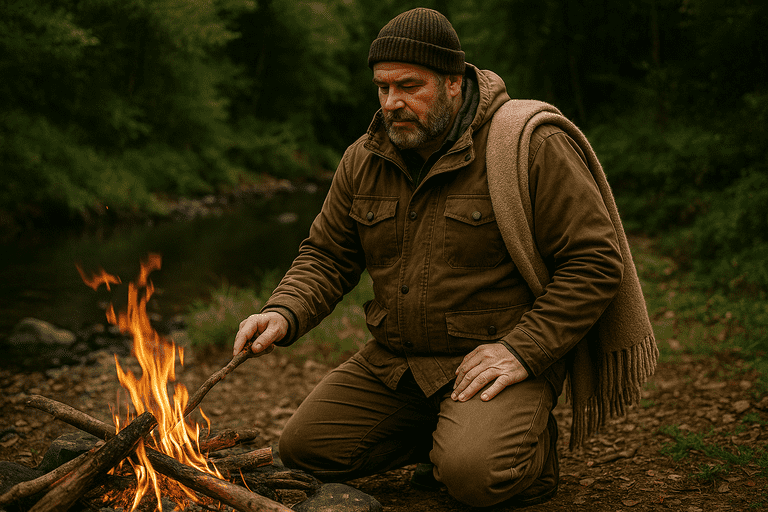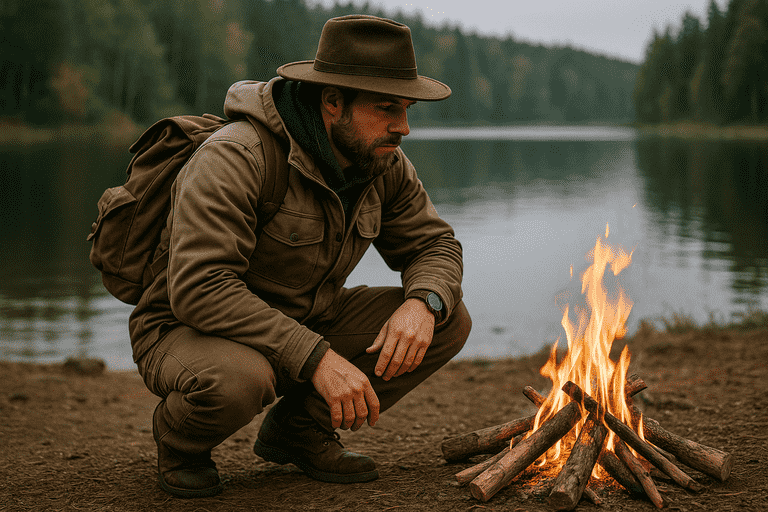Bushcraft clothes are a fundamental part of every outdoor adventure. When venturing into nature, people often focus on tools or navigation devices. However, what you wear plays a vital role in both your safety and comfort. Proper clothing keeps you warm, dry, protected, and agile. In remote environments, these benefits could make the difference between an enjoyable trip and a survival situation.
Wearing the right bushcraft clothes provides more than basic protection. For instance, they allow you to adapt quickly to sudden changes in weather. Whether it’s a cold mountain breeze or an unexpected downpour, being prepared means you’re one step ahead. Additionally, these clothes reduce the risk of injuries caused by thorns, rocks, or insect bites. Therefore, bushcraft gear should always be selected with purpose and care.
Moreover, choosing the right bushcraft gear can improve your mobility. Clothes designed specifically for rugged terrains allow you to bend, climb, and hike without restriction. In addition, high-quality materials reduce sweat buildup, chafing, and overheating. All these factors combined create a more efficient and enjoyable outdoor experience.
Key Features to Look for
Selecting the right bushcraft clothes starts with knowing which features matter most. Durability, for one, is non-negotiable. When you’re outdoors, you’ll encounter everything from sharp branches to rocky paths. Clothes made from reinforced fabrics like canvas or ripstop nylon stand up to the elements. For example, triple-stitched seams add extra longevity.
Water resistance is another essential quality. For instance, a sudden rainstorm could leave you soaked and vulnerable to hypothermia. However, with the proper outer shell, you can stay dry and warm. In addition, windproof materials can keep your core temperature stable in exposed environments.
Bushcraft Survival Kit: Must-Have Items for Safety
Breathability also plays a critical role. Moisture-wicking inner layers help manage sweat, keeping you dry from the inside out. Therefore, it’s crucial to have ventilation zippers or mesh panels in garments like jackets and pants. Also, always look for lightweight options that do not compromise strength or warmth.

Flexibility is often overlooked but highly important. You need clothes that move with your body rather than restrict it. Articulated knees, gusseted crotches, and ergonomic designs are great features to look for. In addition, ample pockets provide space for essential tools and supplies, allowing quick access in critical situations.
Best Materials Used in Bushcraft Clothes
Material selection has a profound impact on performance and durability. Traditional choices like wool and cotton remain popular, especially in cold climates. Wool, in particular, has natural insulation properties, even when wet. Therefore, it’s ideal for base layers and socks. Cotton, although comfortable, is better suited for dry environments due to its tendency to retain moisture.
On the other hand, synthetic blends are engineered for extreme conditions. For example, polyester and nylon fabrics dry quickly and resist tearing. In addition, many high-end bushcraft clothes incorporate a mix of natural and synthetic fibers, combining the best of both worlds.
Modern innovations have introduced materials like softshell fabrics, which offer wind resistance and flexibility. In addition, Gore-Tex and other breathable membranes provide waterproofing without sacrificing ventilation. These materials ensure that you stay dry without overheating during physically demanding activities.
Bushcraft Classes: Rediscovering Nature Skills
Moreover, the development of sustainable materials has changed the landscape. Recycled polyester and organic cotton are now widely used in eco-friendly gear. These options offer the same level of performance while reducing environmental impact. Therefore, you can enjoy nature while also protecting it.
Seasonal Variations
Bushcraft clothing needs vary greatly depending on the season. During the summer, lightweight and breathable fabrics are essential. For example, vented shirts and quick-drying pants allow sweat to evaporate quickly. In addition, UV-protective garments can help reduce the risk of sunburn and heatstroke.
In contrast, winter bushcraft demands insulation and layering. Start with a merino wool base layer, which regulates body temperature. Then, add a fleece or down mid-layer for warmth. Finally, top it off with a windproof and waterproof outer shell. These layers work together to trap body heat and block out the cold.

Spring and autumn are transitional periods where temperatures fluctuate rapidly. For this reason, it’s crucial to dress in versatile layers that can be easily added or removed. Zip-off pants, breathable windbreakers, and thermal shirts are excellent choices. Therefore, always check the forecast and plan accordingly.
Moreover, accessories like gloves, hats, and scarves should match the season. Wool hats and insulated gloves are must-haves in cold weather. On the other hand, breathable caps and lightweight gloves are better suited for summer. Having seasonal gear ready allows you to respond effectively to nature’s unpredictability.
Layering Techniques
Mastering layering is key to staying comfortable and protected in the wilderness. The base layer is your foundation. It should wick away sweat to keep your skin dry. Merino wool or synthetic fabrics work best here. The mid-layer retains body heat. Options include fleece or insulated jackets. Finally, the outer shell shields you from wind and rain.
Each layer serves a specific purpose, and together, they create a comprehensive system. For example, removing your mid-layer during a steep climb prevents overheating. Then, adding it back during rest stops keeps you warm. In addition, ventilation options like pit zips or mesh panels improve air circulation without losing protection.
Adaptability is a major advantage of the layering method. You can easily adjust based on your activity level and weather changes. For instance, a sudden drop in temperature calls for adding an insulated vest or hat. Therefore, carrying multiple layers—even lightweight ones—is always recommended.
Bushcraft Fire Starter: Ignite in Any Condition
Storage also becomes more efficient with this approach. Since each piece serves a unique role, you only bring what you need. In addition, layering allows for fast drying and easy replacement if one item becomes damaged. Overall, it’s a system that maximizes function while minimizing weight and bulk.
How to Choose the Right Fit for Bushcraft Clothes
A good fit improves performance and reduces fatigue. Ill-fitting bushcraft clothes can chafe, bunch, or restrict movement. Therefore, always try gear on before buying, preferably while wearing your base and mid-layers. Movement tests like squatting or reaching can help identify limitations.
For pants, check for features like adjustable waistbands, reinforced knees, and tapered ankles. These details enhance comfort and utility. In addition, articulated joints allow natural movement during climbing or crouching. Well-fitted pants improve agility, reduce snags, and prevent exposure to the elements.

Jackets should have room for layers without looking oversized. Features like adjustable hoods, cuffs, and hems help seal in warmth. Moreover, a longer back panel keeps you covered when bending or sitting. Comfort and protection go hand-in-hand with the right design.
Footwear also contributes to the overall fit system. Ensure your boots match the thickness of your socks and provide ankle support. In addition, proper lacing systems reduce slippage and blisters. Altogether, fit plays a crucial role in your comfort, safety, and endurance during any outdoor trip.
Top Brands Specializing in Bushcraft Clothes
When it comes to investing in reliable bushcraft clothes, certain brands consistently rise to the top. Fjällräven, for instance, is renowned for its G-1000 fabric—a densely woven blend that is wind- and water-resistant while remaining breathable. In addition, their commitment to sustainability and durability has made them a favorite among outdoor enthusiasts.
Helikon-Tex is another standout brand that specializes in tactical and bushcraft-oriented apparel. Their clothing lines often feature modular designs, extra pocket storage, and abrasion-resistant fabrics. For example, their Woodsman Anorak has become iconic among survivalists. Therefore, choosing a trusted brand reduces the trial-and-error process and saves time and money.
Another excellent choice is Woolpower, a Swedish company known for producing high-quality wool base layers. These garments retain heat even in wet conditions and are ideal for colder climates. In addition, their products are ethically made, which appeals to eco-conscious consumers.
Sitka Gear and 5.11 Tactical also offer robust clothing designed for extreme outdoor use. While they may be on the pricier side, their gear performs well in harsh environments. Moreover, brands like Columbia and Patagonia are expanding their bushcraft lines, offering a blend of affordability and innovation. With so many options available, research and field testing are essential to find what suits your specific needs best.
Caring for Your Bushcraft Clothes
Maintaining your bushcraft clothes properly is just as important as choosing the right ones. For example, washing your garments incorrectly can reduce their lifespan and effectiveness. Wool garments should be washed in cold water with mild detergent and laid flat to dry. In contrast, synthetic fabrics often allow for machine washing but may lose performance if exposed to high heat.
In addition, waterproof and windproof items may require periodic reproofing. This involves applying specialized sprays or wash-in treatments that restore their water-resistant properties. Without this upkeep, even the best gear can become ineffective over time.
Storage also plays a critical role. Always store your clothes in a cool, dry place away from direct sunlight. For instance, hanging items in a ventilated wardrobe prevents mold buildup and fabric degradation. Moreover, avoid compressing insulated garments for long periods, as this can affect their loft and thermal efficiency.
Proper care saves money and ensures your gear is ready when needed. Therefore, it’s wise to schedule routine maintenance checks before and after every expedition. With just a little effort, your bushcraft clothes will continue to serve you well for years to come.
Customization Options
Customization allows bushcrafters to adapt their clothing for specific tasks and environments. For instance, sewing on additional pockets or tool loops can greatly enhance functionality. You may also add patches for identity, morale, or camouflage purposes, depending on your setting.
Modular add-ons like zip-on sleeves or removable hoods are increasingly common. These features let you adapt to changing weather without needing a complete outfit change. In addition, features like hook-and-loop panels or MOLLE-compatible gear open up endless configuration options.
Dyeing your clothes in earth tones or camo patterns is another form of personalization. This can help with concealment during tracking or wildlife observation. Moreover, some bushcrafters choose to reinforce high-wear areas like knees or elbows with extra fabric or leather patches.
These customizations do more than add personality—they enhance practicality. Therefore, they’re especially useful for people who spend extended periods in remote locations and want to optimize every piece of their gear. As with all gear modifications, testing them in controlled settings is essential before relying on them in the field.
Combining Functionality and Style
Functionality is key in bushcraft, but that doesn’t mean sacrificing style. Today’s bushcraft clothes are designed with both aesthetics and performance in mind. Earthy tones like olive, brown, and grey not only look natural but also help with blending into outdoor surroundings. For example, a sleek anorak can serve both in the woods and on a city street.
Clothing cuts have evolved as well. Rather than boxy and oversized designs, many modern pieces feature athletic cuts that enhance movement and appearance. In addition, smart placement of seams and zippers avoids bulk and makes layering easier. Therefore, well-designed garments can transition seamlessly between urban and wilderness environments.
Stylish bushcraft clothing also makes a statement. It suggests a lifestyle rooted in self-sufficiency, resilience, and harmony with nature. For some, wearing these clothes is a symbol of preparedness and independence. In addition, well-made clothing often gains character with age, becoming more unique as it weathers the elements.
Ultimately, you don’t have to compromise on looks to achieve great performance. Today’s market offers plenty of stylish options that meet all the necessary functional criteria. This makes it easier to wear your gear every day, not just during outdoor expeditions.
Footwear and Accessories That Complement Bushcraft Clothes
No outfit is complete without the right footwear and accessories. Boots are the foundation of any bushcraft outfit. They should offer ankle support, waterproof protection, and slip-resistant soles. For instance, leather boots with Vibram soles are a popular choice among serious bushcrafters.
In addition, accessories like hats, gloves, belts, and scarves provide both function and comfort. Wool beanies keep your head warm, while wide-brimmed hats protect from sun and rain. Tactical belts often feature built-in tools or storage compartments, enhancing your overall loadout.
Socks are another crucial item. Wool or synthetic blends wick moisture and prevent blisters, unlike cotton socks, which retain moisture. In addition, gaiters protect your lower legs from water, snow, and insects, especially when traveling off-trail.
Layering accessories is as important as layering clothing. For example, combining a moisture-wicking glove liner with an insulated outer glove allows for flexibility in changing weather. Therefore, selecting accessories with care enhances the overall effectiveness of your bushcraft clothes and improves your experience in the wild.
Budgeting for High-Quality Bushcraft Clothes
High-quality gear often comes at a high price, but the investment is worthwhile. While budget-friendly options exist, they may not last as long or perform under extreme conditions. For example, a well-made jacket might cost $250 but last ten years. In contrast, a cheaper $80 version could fail after just one season.
One way to manage costs is to purchase items incrementally. Start with essentials like base layers and boots, then build up your gear over time. In addition, look for end-of-season sales or factory outlet deals. These can significantly reduce the cost of premium items without sacrificing quality.
Used gear is another viable option. Many outdoor communities sell lightly-used gear online. Just be sure to inspect for wear and tear before purchase. Also, pay attention to warranties and repair policies, as brands like Patagonia and Arc’teryx often offer lifetime guarantees.
Think of bushcraft clothes as an investment in safety, comfort, and efficiency. Therefore, allocate your budget according to your most frequent activities. Spending more on gear you’ll use regularly is a smarter move than splurging on specialized items you rarely need.
Innovations and Trends in Bushcraft Clothes
The outdoor clothing industry is constantly evolving. One major trend is the use of recycled materials. For example, many brands now use recycled polyester and nylon to reduce their environmental footprint. In addition, new dyeing processes consume less water and energy.
Smart textiles are also entering the scene. These fabrics respond to body temperature or environmental conditions, adjusting insulation accordingly. For instance, phase-change materials (PCMs) can store and release heat based on ambient temperature. Therefore, future bushcraft clothes may become even more adaptive and efficient.
Another innovation is antimicrobial treatment. This helps reduce odors and the need for frequent washing—an essential benefit on long trips. In addition, lightweight materials with enhanced tear resistance are improving packability without sacrificing strength.
Design is also becoming more inclusive. More brands are offering bushcraft clothes in a wider range of sizes and fits. Gender-specific tailoring and accessibility-focused features are helping more people enjoy the outdoors. These trends reflect a growing understanding of what bushcrafters truly need in the field.
Eco-Friendly Choices in Bushcraft Clothes
As awareness of environmental issues grows, so does the demand for sustainable gear. Eco-friendly bushcraft clothes are made with responsibly sourced materials and ethical labor practices. For example, organic cotton is grown without harmful pesticides, while recycled wool repurposes old garments into new products.
Brands like Patagonia and Icebreaker lead the way in transparency and sustainability. They provide full supply chain information and adhere to strict environmental standards. In addition, biodegradable waterproof coatings and natural dyes are gaining popularity as alternatives to synthetic chemicals.
Making eco-conscious decisions doesn’t mean compromising on performance. Many sustainable fabrics offer the same durability, insulation, and moisture management as conventional ones. In fact, they often last longer because of the quality-focused production process.
Therefore, choosing sustainable gear benefits both you and the planet. Supporting ethical companies encourages better practices across the industry. With more options available every year, it’s easier than ever to find eco-friendly bushcraft clothes that meet your needs.
Real-Life Field Testing of Bushcraft Clothes
The best way to evaluate bushcraft clothes is through real-world testing. Try your gear in diverse conditions—rain, wind, snow, and heat. For example, spending a night in the forest while wearing your complete kit reveals how well it retains heat and repels moisture.
Field testing also exposes potential flaws. A zipper that sticks, seams that rub, or a pocket that’s hard to access may not seem like major issues—until you’re relying on that gear in a survival situation. Therefore, always test your clothing during shorter trips before committing to longer ones.
Keep a log of your experiences. Note what worked, what didn’t, and what could be improved. In addition, photograph wear and tear to track durability over time. This practical feedback becomes invaluable when upgrading or recommending gear to others.
Furthermore, testing builds familiarity and confidence. Knowing how each piece performs allows for better decision-making during emergencies. Over time, your bushcraft clothes become trusted tools—refined by experience and shaped by the wild.

